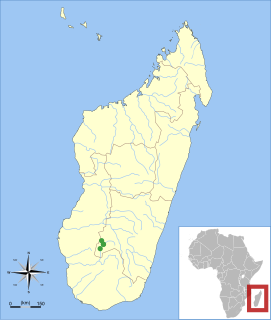
The big brown bat is a species of vesper bat distributed widely throughout North America, the Caribbean, and the northern portion of South America. It was first described as a species in 1796. Compared to other microbats, the big brown bat is relatively large, weighing 15–26 g (0.53–0.92 oz) and possessing a wingspan of 32.5–35 cm (12.8–13.8 in).

The serotine bat, also known as the common serotine bat, big brown bat, or silky bat, is a fairly large Eurasian bat with quite large ears. It has a wingspan of around 37 cm (15 in) and often hunts in woodland. It sometimes roosts in buildings, hanging upside down, in small groups or individually. The name serotine is derived from the Latin serotinus, which means 'evening', while the generic name derives from Greek ἔπιεν and οίκος, which means 'house flyer'.

The long-tongued fruit bat is a species of megabat. It is nectarivorous, feeding on nectar from primarily banana flowers. It is found in several countries in South and Southeast Asia.
Bobrinski's serotine is a species of vesper bat. It can be found in Iran and Kazakhstan.
The Gobi big brown bat is a species of vesper bat. It is found in Afghanistan, China, India, Mongolia, Pakistan, and Russia. Russian zoologist Professor Count Nikolay Alekseyevich Bobrinski first described it in 1926, the type specimen coming from the Altai Mountains in the Gobi Desert.
The sombre bat is a species of vesper bat. It is found only in India. Its natural habitat is subtropical or tropical moist montane forests.

Schlieffen's serotine, also known as Schlieffen's bat or Schlieffen's twilight bat, is a species of vesper bat found in Africa. It has been placed in numerous genera since its first description in 1859, but morphological and genetic studies have confirmed it as the only species in the genus Nycticeinops. It is named for the collector of the original specimen, Wilhelm von Schlieffen-Schlieffiennburg.
The yellow-lipped cave bat is a vespertilionid bat which only occurs in the Kimberley region of northwest Australia. The bat was first captured at Tunnel Creek in 1958 and a description published nearly twenty years later. Aside from observations of their physical characteristics, a preference for caves, and hunting insects over streams, little is known of the species.
The southern forest bat is a vespertilionid bat found in Australia.

The black-bearded tomb bat is a species of sac-winged bat. It is found in South and South East Asia.

The Indian roundleaf bat, also known as the large Ceylon leaf-nosed bat or Kelaart's leaf‐nosed bat is a species of bat in the family Hipposideridae. It is endemic to the Indian subcontinent, with marginal populations also detected in Southeast Asia. Its natural habitats are subtropical or tropical dry forests and caves. The bat has three subspecies that occur in India, Sri Lanka, and Myanmar. The Indian subspecies, H. l. indus, is smaller than the ones found in Sri Lanka and Myanmar, although there are no other characteristics that differentiate the subspecies.

The fawn leaf-nosed bat – Hipposideros cervinus – is a species of bat in the family Hipposideridae found in Australia, Indonesia, Malaysia, the Philippines and Vanuatu.

The Khajuria's leaf-nosed bat, also known as Durga Das's leaf-nosed bat, is a species of bat in the family Hipposideridae. It is endemic to India. Its natural habitat is caves. It is threatened by habitat loss.

The fulvus roundleaf bat or fulvus leaf-nosed bat is a species of bat in the family Hipposideridae. It is found in Afghanistan, Bangladesh, Cambodia, China, India, Laos, Myanmar, Pakistan, Sri Lanka and Thailand and possibly in Vietnam.

Schneider's leaf-nosed bat or Schneider's roundleaf bat is a species of bat in the family Hipposideridae. It is endemic to South Asia. Its natural habitats are subtropical or tropical dry forests, caves, and urban areas.

The black-eared flying fox, species Pteropus melanotus, is a bat of the family Pteropodidae (megabats). Also known as Blyth's flying fox, it is found on the Andaman Islands and Nicobar Islands (India), and in Sumatra (Indonesia). A population on Christmas Island, which is critically endangered, has been placed as a subspecies of this population. The conservation and taxonomic status of that population was later re-established as a distinct species, the Christmas Island fruit-bat Pteropus natalis.

The Isalo serotine is a vespertilionid bat of Madagascar in the genus Laephotis. It is known only from the vicinity of the Isalo National Park in the southwestern part of the island, where it has been caught in riverine habitats. After the first specimen was caught in 1967, it was described as a subspecies of Eptesicus somalicus in 1995. After four more specimens were collected in 2002 and 2003, it was recognized as a separate species. Because of its small distribution and the threat of habitat destruction, it is considered "vulnerable" in the IUCN Red List.

The meridional serotine is a species of bat native to the Iberian Peninsula, Morocco, Algeria, Tunisia and Libya.
The Turkmen long-eared bat is a species of bat in the family Vespertilionidae. It is found in Kazakhstan, Uzbekistan and Turkmenistan, and possibly Mongolia.
Hypsugo alaschanicus, the Alashanian pipistrelle, is a species of bat in the family Vespertilionidae. It is found in China, South Korea, Mongolia, Japan, and Russia.













